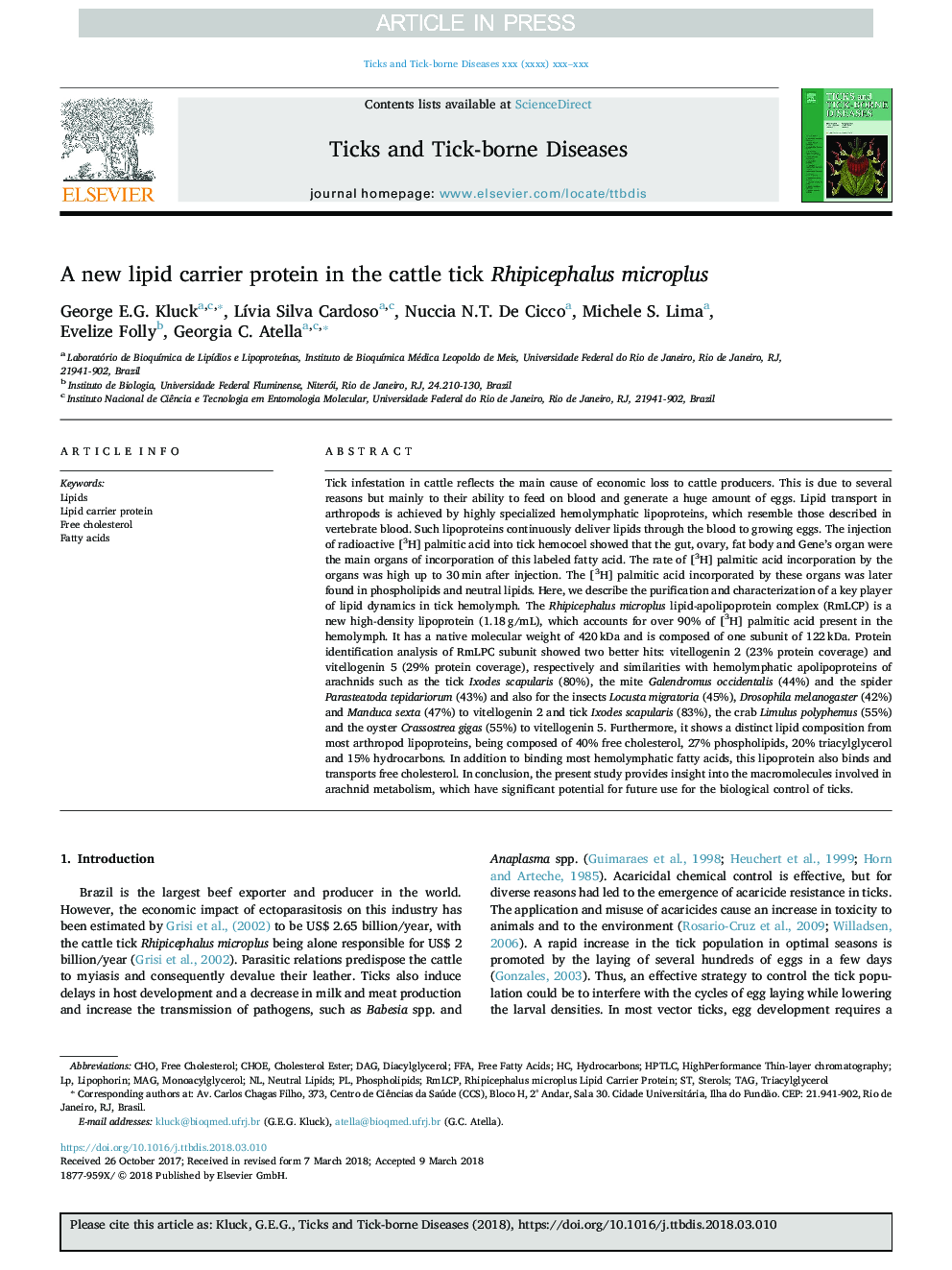| کد مقاله | کد نشریه | سال انتشار | مقاله انگلیسی | نسخه تمام متن |
|---|---|---|---|---|
| 8507201 | 1555960 | 2018 | 10 صفحه PDF | دانلود رایگان |
عنوان انگلیسی مقاله ISI
A new lipid carrier protein in the cattle tick Rhipicephalus microplus
دانلود مقاله + سفارش ترجمه
دانلود مقاله ISI انگلیسی
رایگان برای ایرانیان
کلمات کلیدی
monoacylglycerolMAGHPTLCFFASterols - استرول هاFatty acids - اسیدهای چربFree fatty acids - اسیدهای چرب آِزادCho - برایtriacylglycerol - تری آسیل گلیسرول TAG یا triacylglycerols - تری گلیسرید یا تری آسیل گلیسرولdiacylglycerol - دیسیل گلیسیرینDAG - روزPhospholipids - فسفولیپیدLipophorin - لیپوفورینneutral lipids - لیپید های خنثیHydrocarbons - هیدروکربنLipids - چربیهاChoE - چیهCholesterol ester - کلسترول استرfree cholesterol - کلسترول رایگان
موضوعات مرتبط
علوم زیستی و بیوفناوری
علوم کشاورزی و بیولوژیک
علوم دامی و جانورشناسی
پیش نمایش صفحه اول مقاله

چکیده انگلیسی
Tick infestation in cattle reflects the main cause of economic loss to cattle producers. This is due to several reasons but mainly to their ability to feed on blood and generate a huge amount of eggs. Lipid transport in arthropods is achieved by highly specialized hemolymphatic lipoproteins, which resemble those described in vertebrate blood. Such lipoproteins continuously deliver lipids through the blood to growing eggs. The injection of radioactive [3H] palmitic acid into tick hemocoel showed that the gut, ovary, fat body and Gene's organ were the main organs of incorporation of this labeled fatty acid. The rate of [3H] palmitic acid incorporation by the organs was high up to 30â¯min after injection. The [3H] palmitic acid incorporated by these organs was later found in phospholipids and neutral lipids. Here, we describe the purification and characterization of a key player of lipid dynamics in tick hemolymph. The Rhipicephalus microplus lipid-apolipoprotein complex (RmLCP) is a new high-density lipoprotein (1.18â¯g/mL), which accounts for over 90% of [3H] palmitic acid present in the hemolymph. It has a native molecular weight of 420â¯kDa and is composed of one subunit of 122â¯kDa. Protein identification analysis of RmLPC subunit showed two better hits: vitellogenin 2 (23% protein coverage) and vitellogenin 5 (29% protein coverage), respectively and similarities with hemolymphatic apolipoproteins of arachnids such as the tick Ixodes scapularis (80%), the mite Galendromus occidentalis (44%) and the spider Parasteatoda tepidariorum (43%) and also for the insects Locusta migratoria (45%), Drosophila melanogaster (42%) and Manduca sexta (47%) to vitellogenin 2 and tick Ixodes scapularis (83%), the crab Limulus polyphemus (55%) and the oyster Crassostrea gigas (55%) to vitellogenin 5. Furthermore, it shows a distinct lipid composition from most arthropod lipoproteins, being composed of 40% free cholesterol, 27% phospholipids, 20% triacylglycerol and 15% hydrocarbons. In addition to binding most hemolymphatic fatty acids, this lipoprotein also binds and transports free cholesterol. In conclusion, the present study provides insight into the macromolecules involved in arachnid metabolism, which have significant potential for future use for the biological control of ticks.
ناشر
Database: Elsevier - ScienceDirect (ساینس دایرکت)
Journal: Ticks and Tick-borne Diseases - Volume 9, Issue 4, May 2018, Pages 850-859
Journal: Ticks and Tick-borne Diseases - Volume 9, Issue 4, May 2018, Pages 850-859
نویسندگان
George E.G. Kluck, LÃvia Silva Cardoso, Nuccia N.T. De Cicco, Michele S. Lima, Evelize Folly, Georgia C. Atella,